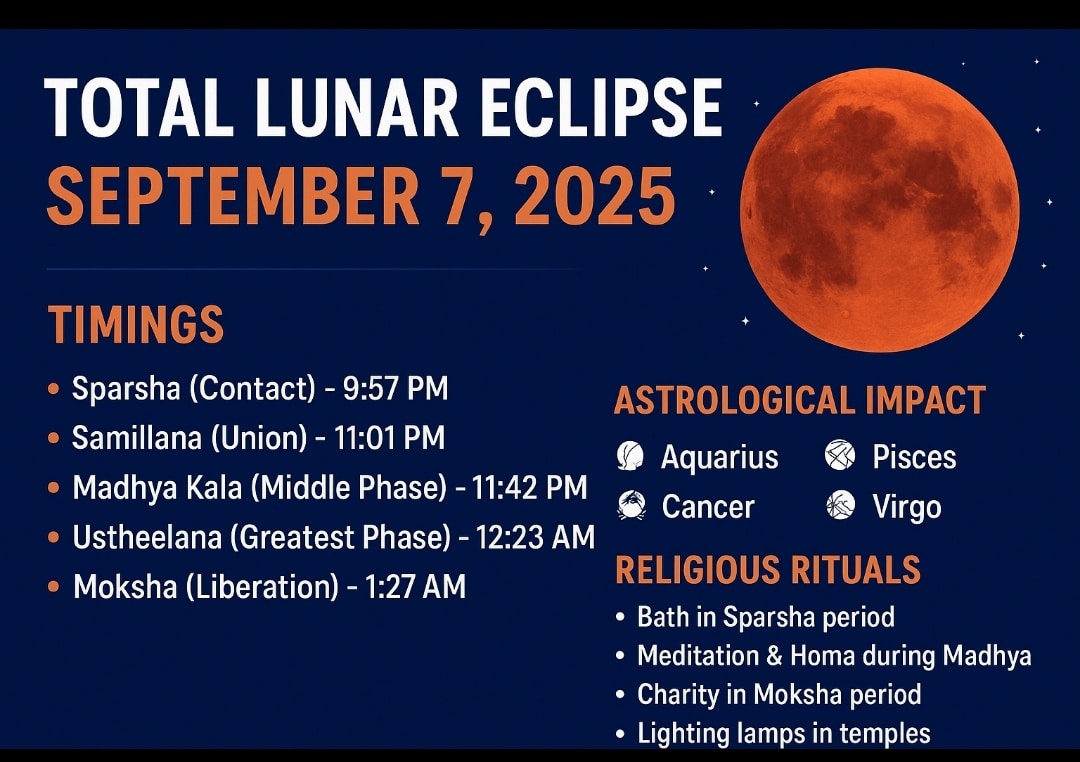
Introduction
On September 7, 2025, the skies above India and several parts of the world will witness a rare and significant astronomical event — a Total Lunar Eclipse. This celestial phenomenon will occur when the Moon passes through Earth’s shadow and will be visible as a deep red “Blood Moon.”
Astrologically, the eclipse takes place in Purvabhadra Nakshatra within the Aquarius sign, where the Moon comes under the influence of Rahu (North Node). While scientists study such eclipses for cosmic insights, in Indian astrology, eclipses are believed to hold powerful spiritual, karmic, and even practical consequences.
For certain zodiac signs such as Aquarius, Pisces, Cancer, and Virgo, this eclipse may bring challenges, while others may experience opportunities for growth and transformation. Religious traditions prescribe specific rituals, fasting, and chanting during eclipse hours for purification and remedies.
Eclipse Timings for September 7, 2025
The detailed schedule of the total lunar eclipse is as follows (IST – Indian Standard Time):
Penumbral Phase Begins (Sparsha – Contact): 9:57 PM
Partial Eclipse Begins (Samillana – Union): 11:01 PM
Totality Begins (Madhya Kala – Middle Phase): 11:42 PM
Maximum Eclipse (Ustheelana – Greatest Phase): 12:23 AM (September 8)
End of Eclipse (Moksha – Liberation): 1:27 AM (September 8)
Punya Kala (Auspicious Period): until 3:30 AM
These timings hold both scientific and spiritual importance, especially in Hindu traditions where rituals are aligned with eclipse phases.
What is a Lunar Eclipse?
A lunar eclipse occurs when the Earth, Sun, and Moon align in a straight line. The Earth blocks sunlight, casting its shadow on the Moon. Depending on the alignment:
Total Lunar Eclipse (Khagraasa Chandragrahana): The Moon is completely immersed in Earth’s umbral shadow.
Partial Lunar Eclipse (Ardhagraasa): Only a part of the Moon is shadowed.
Penumbral Eclipse: The Moon passes through the lighter part of Earth’s shadow, appearing dim.
This September event is a Total Eclipse, turning the Moon into a striking blood-red hue due to Rayleigh scattering of sunlight through Earth’s atmosphere.
Mythological and Cultural Background
In Hindu mythology, eclipses are tied to the story of Rahu and Ketu. During the churning of the ocean (Samudra Manthan), the demon Rahu disguised himself to drink Amrit (nectar of immortality). But Lord Vishnu, upon realizing this, used his Sudarshana Chakra to sever Rahu’s head.
Though separated, Rahu and Ketu became immortal celestial entities. They are believed to cause eclipses by “swallowing” the Sun and Moon, symbolizing karmic lessons and cosmic balance.
Hence, lunar eclipses are viewed not just as cosmic events but as times of karmic reckoning, purification, and spiritual focus.
Religious Significance and Rituals
Hindu traditions emphasize rituals during eclipses, believing them to be powerful moments for spiritual cleansing:
- Sparsha Kala (Beginning – 9:57 PM):
Ritual bath for purification.
Avoid cooking and eating after this point.
- Madhya Kala (Mid-Eclipse – 11:42 PM):
Best time for meditation, mantra chanting, and Homa (fire rituals).
“Chandra Rahu Japa” is highly recommended.
- Moksha Kala (End – 1:27 AM):
Ideal time for donations (daan) such as sesame oil, rice, lentils, and money.
Another ritual bath for cleansing negative influences.
- Punya Kala (3:30 AM):
Period of auspicious merit — completing fasts, prayers, and acts of charity.
Traditional Remedies
Sesame Oil Donation: Half-liter of pure sesame oil with ₹51 offering.
Grain Offering: White cloth wrapped rice and black cloth wrapped urad dal offered while chanting “Chandraya Namah, Rahave Namah.”
Lighting Lamps: Offering ghee lamps in temples is considered highly beneficial.
Food Discipline: Finish meals before 1 PM, observe fasting during the eclipse, and break it with fruits or light food after sunrise.

Health Precautions During Eclipse
While science states that eclipses pose no direct physical harm, traditions prescribe certain precautions:
Pregnant Women: Avoid cutting or stitching, sharp tools, or stepping outside during the eclipse.
Children and Elderly: Stay indoors, rest, and focus on prayer or meditation.
Food & Drinks: Cover food items; placing tulsi (holy basil) leaves in water and food is a common practice.
Astrological Impact: Effects on Zodiac Signs
The total lunar eclipse falls in Purvabhadra Nakshatra in Aquarius sign (Kumbha Rashi). Its influence differs across zodiac signs:
Signs Facing Challenges (Arishta Rashis)
Aquarius (Kumbha): Emotional stress, confusion in decision-making, delays in work.
Pisces (Meena): Financial instability, strained relationships, inner conflict.
Cancer (Karka): Health issues, family disputes, emotional imbalance.
Virgo (Kanya): Obstacles in career, criticism, misunderstandings in partnerships.
Nakshatras Facing Adverse Impact
Purvabhadra
Uttarabhadra
Revati
Punarvasu
Pushya
Ashlesha
Uttaraphalguni
Hasta
Chitra
Natives of these stars are advised to perform remedies, mantra chanting, fasting, and donations for protection.
Scientific Perspective
NASA and ISRO confirm that this eclipse will be visible across:
Asia (including India, Nepal, Bangladesh, Sri Lanka)
Africa
Europe
Australia (parts)
During totality, the Moon will glow crimson red — popularly called a Blood Moon. Scientists will use this opportunity to study lunar surface changes, atmospheric effects, and celestial alignments.
Historical Eclipses of Note
July 27, 2018: The longest lunar eclipse of the 21st century (1 hour 42 minutes).
November 8, 2022: A full lunar eclipse visible in India.
September 7, 2025: Upcoming total eclipse with wide visibility and deep astrological significance.
Folklore and Beliefs
In rural India, many cultural beliefs still guide practices during eclipses:
Pregnant women should not sew or cut.
Children should not play outdoors.
Food should not be consumed or cooked.
Cattle should not be fed green fodder.
Though lacking scientific basis, these traditions are still followed for cultural continuity and perceived safety.
Global Observations
This total lunar eclipse will captivate skywatchers worldwide. From Japan and China to Europe and Africa, people will witness the dramatic “Blood Moon.”
Astronomers will set up telescopes and livestreams for public viewing.
Social media will be flooded with pictures of the eclipse.
Cultural and religious groups will organize community gatherings, prayers, and discussions.
Remedies and Protection Measures
Astrologers advise the following remedies for those most affected:
Mantras: Reciting “Chandraya Namah” and “Rahave Namah” 108 times.
Homa & Tarpana: Fire rituals and offerings to ancestors.
Charity: Donating sesame seeds, ghee, grains, and clothes to the needy.
Temple Visits: Lighting ghee lamps post-eclipse.
Conclusion
The Total Lunar Eclipse of September 7, 2025 is not just an astronomical wonder but also a spiritually charged event in Indian culture.
From a scientific lens, it provides insights into cosmic alignments. From a religious perspective, it is a time for reflection, prayer, and karmic cleansing. Astrologically, it influences certain zodiac signs and nakshatras, requiring remedies and mindful rituals.
For believers, the eclipse is an opportunity for inner purification, devotion, and renewal of faith. For astronomers, it’s a spectacular celestial phenomenon. And for all of us, it is a reminder of the grand dance of the cosmos.




